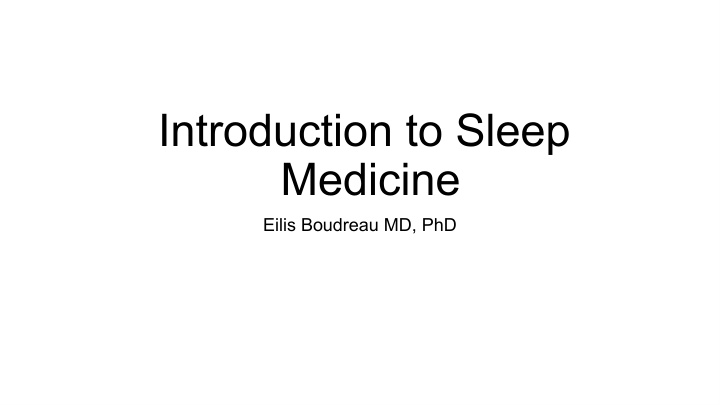



Introduction to Sleep Medicine Eilis Boudreau MD, PhD
What is Sleep? • Alternates with waking • Associated with postural change (recumbent in humans) • Decreased response to sensory stimuli • Low levels of motor activity • Rebound if deprived of sleep Phyllis Zee, Update on the Science, Diagnosis, and Management of Insomnia, International Congress and Symposium Series 262, 2006, pg 4
2-Process Model of Sleep Regulation (Borbely 1982)
Sleep Architecture N1 (5%) R1 (25%) N2 (50%) N3 (20%)
Sleep Cycles • Approximately 90-110 minutes • 4-6 cycles per night • During first cycles R1 (REM) only a few minutes • First 2 cycles have significant N3 • Later cycles dominated by R1
Sleep Staging is based on which of the following? • Breathing Patterns • Arousal Patterns • Electroencephalogram (EEG) Patterns • Oxygen Saturation Patterns • EKG Patterns
Sleep Requirements Vary with Age (National Sleep Foundation)
Sleep Patterns with Aging • substantial ↑ in variability from individual to individual • ↓ total sleep time • ↓ sleep efficiency • ↓ time to REM onset • ↑ sleep fragmentation • N3 (slow-wave sleep) may ↓
Physiologic Changes During Sleep Non-REM REM Cardiovascular ↓HR, ↓ BP, ↓variability ↑ HR, ↑ variability Respiratory ↓RR, ↓variability ↑ RR, ↑ variability Neuromuscular tonic atonic Endocrine ↓ urine output
Most Common Sleep Disorders • Sleep Disordered Breathing • Sleep Related Movement Disorder (ex. Restless Leg Syndrome) • Insomnia • Parasomnia • Central Disorders of Hypersomnia (ex. Narcolepsy) • Circadian Rhythm Sleep-Wake Disorders
What is Sleep Apnea? https://www.sleepwell.org/snoring/
Sleep Apnea: Physiology Increased upper Increased effort airway collapsibility to breath • Oxygen level can drop (but not • Increased sympathetic activity always) (fight or flight reaction) • Blood vessels constrict • CO 2 l level increases increased blood pressure (BP) • Increased BP reflex bradycardia (decreased heart rate) • Tachycardia (increased heart rate) with recurrent arousals
Why is Sleep Apnea a Problem? • Poor daytime functioning • Increased risk of hypertension • Increased risk of accidents • Irritability poor social interactions
Obstructive Sleep Apnea Risk Factors Presenting Symptoms • Increased body weight • Snoring (but many people snore and DON’T have • Age apnea) • Large neck circumference • Witnessed apneas • Airway • Excessive daytime sleepiness • M > F • AM headaches • Menopause • Dry mouth
Sleep Apnea and Performance • Chronic partial sleep deprivation • Decreased attention • Individual often has poor insight into impaired performance 2°sleep apnea • Even brief lapses in attention can lead to injury (eg. when driving)
Sleep Apnea Treatment • Continuous Positive Airway Pressure (CPAP) • Mandibular Advancement Device • Surgery • Palate/oral surgery • Inspire TM (implanted breathing stimulation device) • Other • Weight loss • Avoid alcohol
How is Sleep Measured? • In-Lab Sleep Study • Home Sleep Study • Breathing, EEG, EMG • Breathing, O2, + (monitoring muscle activity), O2, EKG
In-lab Polysomnography vs Home Sleep Testing In-Lab Home Sleep Testing • Measures of breathing, EEG, • Large # of different devices, oxygenation, position, video, with varying # of signals movements • Patient takes device home • 1 technician per every 2 • Much cheaper patients • Fewer signals and data • Inconvenient • Not appropriate for everyone • Expensive
National Sleep Research Resource (NSRR) • Collection of de-identified data from well characterized sleep cohorts • Includes clinical data elements and physiologic signal data (ex. Polysomnography data), tools for analysis • Purpose is to make data available for secondary analysis, teaching • Supported by National Heart, Lung, Blood Institute at NIH • https://sleepdata.org
Sleep Heart Health Study • Multi-site cohort study • Designed to determine whether sleep-disordered breathing is associated with hypertension (high blood pressure), cardiac disease, stroke, and all cause mortality • 6441 individuals 40 years or older were enrolled between 1995 and 1998 • Participants were evaluated at three time points over study period (1995 – 2003)
Sleep Heart Health Study • Patients recruited from 9 epidemiologic cohorts in which cardiovascular outcomes had been collected: Framingham Offspring Cohort Hagerstown & Minneapolis/St. Paul sites of Atherosclerosis Risk in Communities (ARIC) study Hagerstown, Sacramento & Pittsburgh sites of Cardiovascular Health Study (CHS) Strong Heart Study sites in South Dakota, Oklahoma, & Arizona Respiratory & Hypertension (HTN) disease studies in Tucson & New York
Sleep Heart Health Study • Data collected included: • In-home sleep studies at the 1 st & 3 rd study visits • Demographic data • Cardiovascular outcomes data
Sleep Heart Health Study • Data was extracted from the SHHS using the NSRR website • Exercises for the course use this extracted data • Your completion of data use request through NSRR site is good example of data use agreement
Questions?
Recommend
More recommend